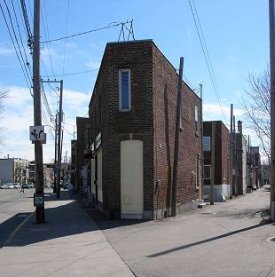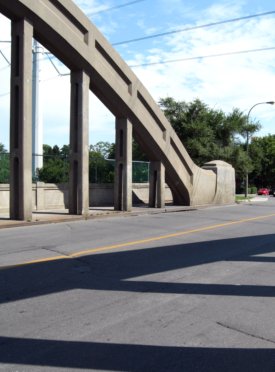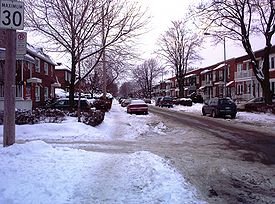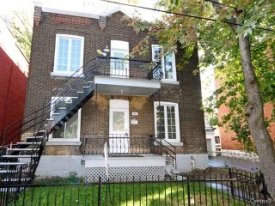|
Verdun BoroughVerdun District
Now that the Verdun district is completely urbanized, it takes a considerable leap of imagination to see how the neighborhood and the countryside that surrounded it then looked like 300 years ago. The Lower Lachine Road which follows the St-Lawrence River, was originally a path used by the Mohawks and other Amerindians. The road was extremely important because it crossed the territory and linked the Paroisse des Saints-Anges de Lachine to the Paroisse de Notre-Dame de Montréal. 
At the beginning of the 19th century, the aspect of the territory is transformed by the construction of the Montreal Aqueduct that encloses the Verdun district on its northern side. It is rather difficult to imagine the district without the Canal Lachine Montreal. After it had been built, the residents who wanted to go to Côte-Saint-Paul could, much to their pleasure, cross one of the many bridges that hang over the canal. They still do. Downtown Verdun is bordered by the Highway 15 also called Décarie Expressway in the east, by the Desmarchais Boulevard in the west, by the canal of the Montreal Aqueduct in the north and by the St-Lawrence River in the south. In 1991, about half of the population of the district resided in this enclosed area. Modern Home Architecture 
What still strikes is the disparity between the various sectors. In the east, the territory kept its old houses dating back to the 1930’s. In the centre and in the west, in the Desmarchais-Crawford electoral district, houses dating back to the 1940’s and 1950’s still dominate the scenery. In the 1970’s, new houses were built on the ruins of old or damaged ones. The few rare grounds that were still available such as those located on the banks of the River between LaSalle Boulevard and the St-Lawrence River were used to build new houses. 
The Desmarchais-Crawford area is residential and bordered to the east by the Desmarchais Boulevard, to the west by the limits of LaSalle, to the north by the canal of the Montreal Aqueduct and to the south by the St-Lawrence River. At the end of Woodland close to the LaSalle Boulevard, rises an extremely interesting building signed by the architect Jean-Maurice Dubé. The Centre d'hébergement du Manoir with a capacity of 320 rooms was inaugurated in 1970. 
Except for the Poudrière that now houses condos, the three STM Montreal Metro Stations built in 1978, LaSalle, de l’Église and Verdun did not bring any major modifications to the urban landscape of the district. However, the vast vacant grounds left by the demolition of the old Defence Industries Limited (DIL) factory in 1980 yielded the place for condos and metamorphosed the area. Ultimately, the size and the quality of the district’s various housing developments became quite diversified. They now reflect the various fortunes and social conditions of the inhabitants as well as the inherent qualities and defects of a normal urbanization process. Thank you for visiting Verdun District. Images Montreal Exit Verdun District
|
Montreal Districts
What district am I in?
Ahuntsic
Anjou
Cartierville
Côte-des-Neiges
Hochelaga-Maisonneuve
Île Bizard
Lachine
LaSalle
Mercier
Montréal-Nord
Notre-Dame-de-Grâce
Outremont
Parc-Extension
Petite-Patrie
Pierrefonds
Plateau-Mont-Royal
Pointe-aux-Trembles
Rivière-des-Prairies
Rosemont
Roxboro
Sainte-Geneviève
Saint-Laurent
Saint-Léonard
Saint-Michel
Sud-Ouest
Verdun
Ville-Marie
Villeray
Atlas de l'emploi
Images Montréal
Images Montreal is a huge project that aims to be the biggest exclusive website of Montreal's skyscrapers, historical buildings and architecture landmarks.
Old historical monuments have a lot of interest as much as new apartment buildings, new skyscrapers or graffitis.
Montreal by Metro
Montreal by Metro is an unofficial website for fans of Montreal's metro system.
Our modern rapid transit system is one of the most architecturally distinctive subway systems in the world.
Unlike many other subway networks, every station in Montreal is distinct.
The system is beautifully decorated with hundreds of pieces of public art, including sculptures, frescoes, and stained glass.
STM Montréal
STM Montreal is composed of 68 metro stations spread along four lines and of a network made of 170 daytime and 20 night time bus service routes.
The metro provides 1.3 million trips every day. STM Montreal web site also offers a section called Art in the Métro.






